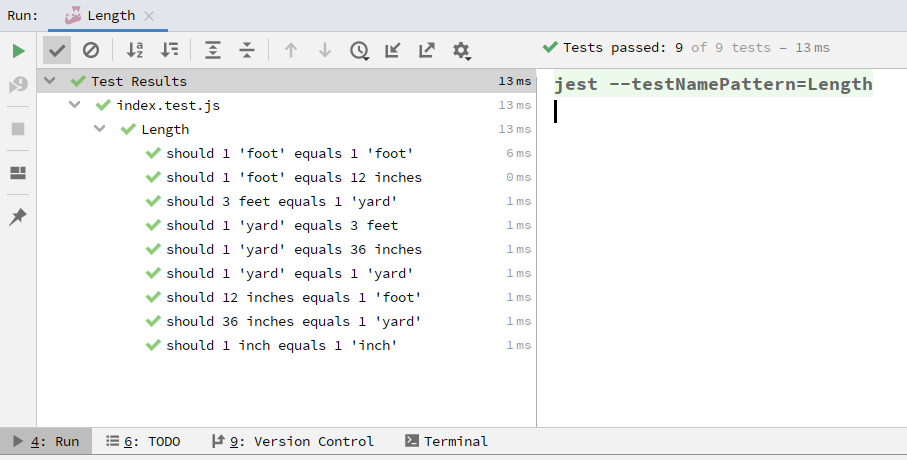单位转换——重构系列学习笔记
一、题目介绍
这是一道简单的长度单位之间的换算题,代码已经由你的前任程序员写好,但是……实现实在并不怎么优雅,好在前任还算负责,写了很多单元测试。这一课的任务就是对已有的代码做出修改,使它变得更可读,维护性更好。你可以先把代码拉下来,读读README.md里描述的需求,再随意读读代码感受一下,有兴趣的话你也可以尝试上手重构一把。
JavaScript:
1 | git clone https://github.com/linesh-simplicity/length.git |
二、练习过程
task-01
看着一团糟的代码,确实是日常工作中经常可以见到的代码,迫不及待的上手重构了一下,然而…
1 | parseTo(u) { |
除了结构整齐了,还是有明显的坏味道
task-02
这一次,只针对不友好的命名做重构~
1 | conversionTo(targetUnit) { |
重构的过程中,随时运行测试,一定牢牢记住小步前进

思考
有没有做到每修改一处代码就运行测试?
答:修改了好几处才想起来, 并没有养成随时运行测试的习惯,应该更频繁的运行测试
你是如何为变量和方法重命名的?全局搜索/替换?使用快捷键?不同的办法之间有什么优劣?
答:最开始用Pycharm , 可能是版本配置的问题,快捷键重命名后代码总是有问题,使用
Alt+J批量替换了一些,之后就安装了webstorm , 批量替换正对字符串,在引用较多的情况下或者有其他变量存在相同字符串的时候,很容易出问题,而依赖Shift+F6 则不容易出现这种问题,更安全
好的命名应该是什么样子?平时工作中的代码元素(变量、函数、类名、常量等)有没有命名不好的例子?
好的命名,简单明了,重点是明了,然后再是简单。 遵循规范,可以清晰的表现出用途,同时也相对简洁。
命名不好的例子:
1
2
3
4
5
6var thLen = $('#maintable thead th').length;
var $trs = $('.m_table tbody tr');
var trLen = $trs.length;
var $fixThs = $('#fixtable th');
var $mainThs = $('#maintable th');
var $fixAs = $('#fixtable th a');如果你不知道 IDE 对“重命名”这个重构操作有快捷键支持,请你搜索一下,应用到重构中去
这个用的已经比较熟练,日常工作中几乎所有重命名操作都依赖快捷键
重构的节奏顺畅吗?若有不顺畅的地方在哪里?
环境方面遇到一点问题,更换IDE后解决
task-03
重构目标:
- 重复的字符串提取为常量
重构第一步:
1 | parseTo(unit) { |
然后,测试代码中也存在很多单位字符串的使用,此时的重构结果很是不让人满意,因此,下一步我创建了一个新的Unit类
1 | export class Unit { |
替换所有用到这些地方的字符串
1 | import { Unit } from './unit' |
包括测试代码中的
1 | import { Length } from './index' |
最后,将f干掉
1 | export class Unit { |
task-4
在第3步就已经完成这这一步需要做的操作,可能步子还是有点大
总结一下吧
思考:
你还能做到重构过程每分钟都保持运行测试并且测试通过的状态吗?
这次测试运行的很频繁,好几次出现的测试运行失败,立马先恢复,这种感觉很安全
过程中有没有不顺畅的地方?
对JS面向对象的语法不够熟悉,看了下task-4才知道
static关键字你选择先更换哪个方法的声明?你觉得重构的先后次序有区别吗?
重构的先后次序对结果的影响可能不大,但不同的次序重构的难度是不一样的
task-5
练习三遍
第一遍使用快捷键加批量替换,有些时候,重构快捷键并不是那么智能,可以配合替换快捷键使用提高效率
第二遍使用纯手工替换每一个变量,每替换一个,就运行一次测试,很有安全感
第三遍再会到快捷键操作,还是快捷键效率高
思考:
- 注意体会“旧的不变、新的创建”这个创建重构中间状态的过程
- 重构的过程有没有更加顺畅?
- 重构的次序能不能进一步优化?
task-6
这一节的任务,是提炼计算函数
动手之前,先花几分钟思考一下重构步骤:如何做到平滑替换?
旧的不变,新的创建,一步切换,旧的再见
严格按照重构步骤执行重构,频繁运行测试
git checkout final看一下参考步骤,找出与你设定步骤的异同多练几遍
第一步:
创建一个新的函数
1 | getLength(value, unit) { |
使用这个函数替换 new Length()的调用
1 | parseTo(unit) { |
然后,消除嵌套的if表达式
1 | parseTo(unit) { |
殊途同归,又回到了第一次重构时的结构,但总觉的有些不对,看看示例,有一个坏味道被我忽略了
示例代码:
1 |
|
重复的this.getLength() 和重复的 new Length()真的有很大的区别吗?
事实证明,没有仔细审题就动手的后果很严重!
仔细观察,其实
Length对象的创建过程,唯一区别是在计算不同的value值。不过,要消除重复的对象创建代码,我们还得做点准备工作,那就是把这部分关于value的计算逻辑先剥离出来。
这次的任务是提炼计算函数,计算函数就是计算value的逻辑,如何平滑切换呢?
十六字心法背的很熟练,旧的不变,新的创建,先创建什么呢?
先创建一个新的变量_value代表每次计算逻辑计算后的值,需要注意的是,parseTo函数,即时传入的unit不能满足所有的条件,也是有返回的,这种情况下返回的就是当前对象本身,因此计算出的value实际就是this.value
1 | let _value = this.value |